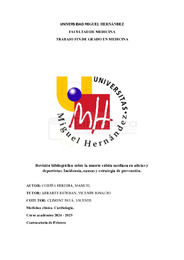Please use this identifier to cite or link to this item:
https://hdl.handle.net/11000/37634Full metadata record
| DC Field | Value | Language |
|---|---|---|
| dc.contributor.advisor | Arrarte Esteban, Vicente Ignacio | - |
| dc.contributor.advisor | Climent Payá, Vicente Eduardo | - |
| dc.contributor.author | Cortés Heredia, Manuel | - |
| dc.contributor.other | Departamentos de la UMH::Medicina Clínica | es_ES |
| dc.contributor.other | Departamentos de la UMH::Medicina Clínica | es_ES |
| dc.date.accessioned | 2025-10-06T09:31:57Z | - |
| dc.date.available | 2025-10-06T09:31:57Z | - |
| dc.date.created | 2025-02-06 | - |
| dc.identifier.uri | https://hdl.handle.net/11000/37634 | - |
| dc.description.abstract | Los beneficios que genera la práctica deportiva diaria a nivel de salud cardiovascular son indiscutibles. Sin embargo, y asociada al deporte, la muerte súbita cardíaca (MSC) es un fenómeno trágico que genera gran repercusión cuando ocurre en deportistas de élite. La incidencia de este evento sigue siendo controvertida y desconocida a día de hoy, entre otros motivos, debido a falta de consenso en establecer una misma metodología de investigación. Respecto a la estrategia de prevención de la MSC, destaca gran controversia en torno a la decisión de incluir o no el ECG durante el cribado de atletas. Por un lado, las guías europeas defienden que el ECG aportaría mayor sensibilidad situándose a favor y, por el otro lado, las guías americanas argumentan una mayor tasa de falsos positivos que les hace estar en contra. Sin embargo, algo en lo que sí coinciden ambos enfoques, es que si queremos identificar precozmente a aquellos individuos con mayor predisposición de sufrir MSC será importante conocer los factores de riesgo asociados (edad, etnia, sexo e intensidad del ejercicio) y personalizar la estrategia de prevención. En cuanto a las causas de la MSC, se ha observado una gran diferencia entre atletas de mayor (>35 años) o menor edad (<35), siendo la enfermedad coronaria arteriosclerótica la principal causa etiológica en >35 años, , mientras que en los atletas menores las principales causas son alteraciones genéticas subyacentes que causan trastornos funcionales o estructurales (miocardiopatías y canalopatías). | es_ES |
| dc.description.abstract | The benefits of daily sports practice on cardiovascular health are undeniable. However, sudden cardiac death (SCD) associated with sports is a tragic phenomenon that generates significant impact when it occurs in elite athletes. The incidence of this event remains controversial and largely unknown, partly due to the lack of consensus on establishing a unified research methodology. Regarding SCD prevention strategies, there is considerable debate surrounding the inclusion of ECG in athlete screening. On the one hand, European guidelines advocate for ECG inclusion, arguing that it provides greater sensitivity. On the other hand, American guidelines oppose its use due to a higher rate of false positives. Nevertheless, both approaches agree on the importance of identifying individuals at higher risk for SCD by recognizing associated risk factors (age, ethnicity, sex, and exercise intensity) and tailoring prevention strategies accordingly. As for the causes of SCD, a significant difference has been observed between older (>35 years) and younger (<35 years) athletes. Specifically, coronary atherosclerotic disease is the leading etiological cause in older athletes, while in younger ones, underlying genetic abnormalities causing functional or structural disorders (such as cardiomyopathies and channelopathies) are the primary contributors. | es_ES |
| dc.format | application/pdf | es_ES |
| dc.format.extent | 26 | es_ES |
| dc.language.iso | spa | es_ES |
| dc.publisher | Universidad Miguel Hernández | es_ES |
| dc.rights | info:eu-repo/semantics/openAccess | es_ES |
| dc.rights | Attribution-NonCommercial-NoDerivatives 4.0 Internacional | * |
| dc.rights.uri | http://creativecommons.org/licenses/by-nc-nd/4.0/ | * |
| dc.subject | Muerte súbita cardíaca | es_ES |
| dc.subject | atleta | es_ES |
| dc.subject | incidencia | es_ES |
| dc.subject | epidemiología | es_ES |
| dc.subject | causas | es_ES |
| dc.subject | cribado | es_ES |
| dc.subject | competición deportiva | es_ES |
| dc.subject.other | CDU::6 - Ciencias aplicadas::61 - Medicina | es_ES |
| dc.title | Revisión bibliográfica sobre la muerte súbita cardíaca en atletas y deportistas. Incidencia, causas y estrategia de prevención. | es_ES |
| dc.type | info:eu-repo/semantics/bachelorThesis | es_ES |

View/Open:
CORTÉS HEREDIA, MANUEL, TFG.pdf
806,69 kB
Adobe PDF
Share:
.png)
